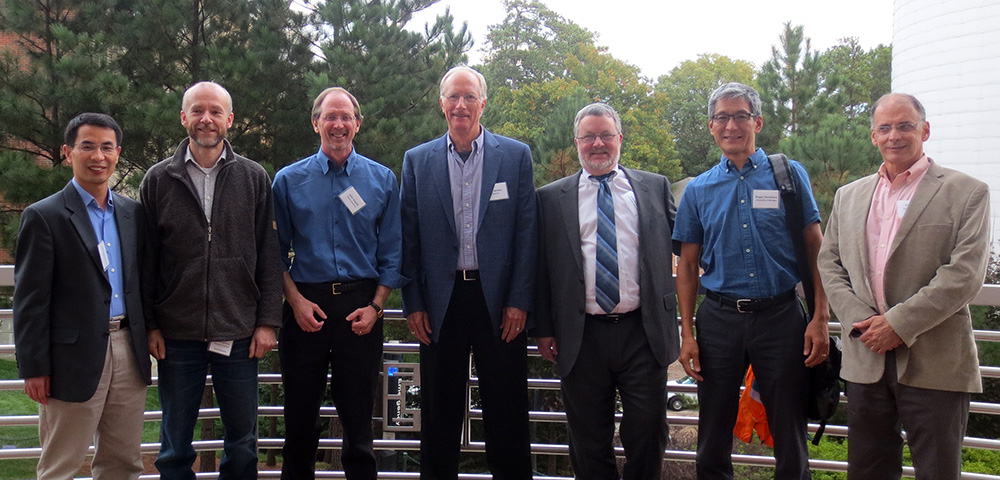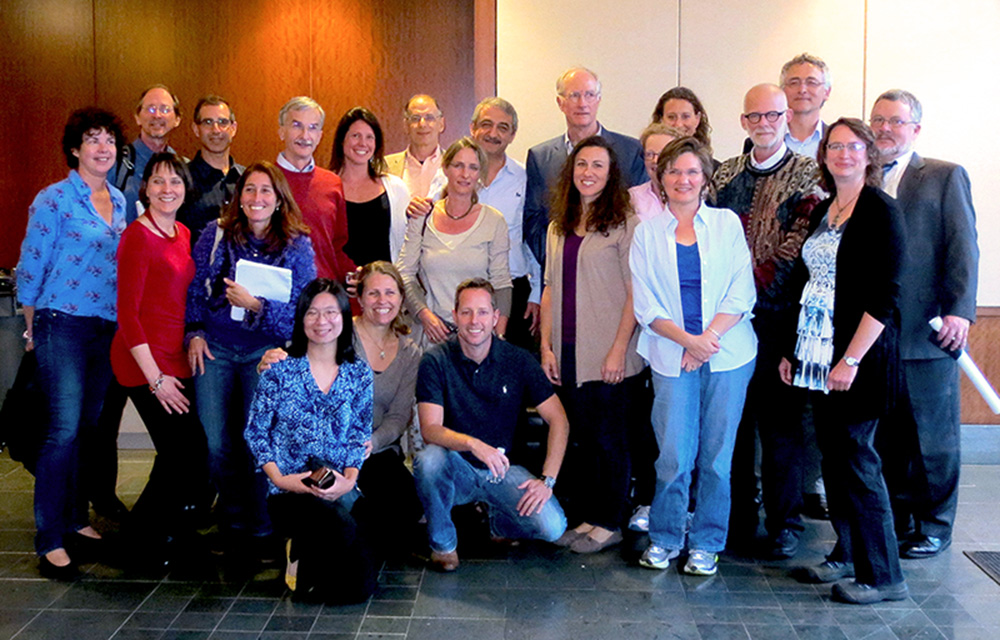
Above photo: Ken with symposium speakers (L to R): Qisheng Zhang, Len Stephens, John Hepler, Ken, Alex Brown, Roger Sunahara and Eduardo Lazarowski.
The Pharmacology department hosted a half-day symposium on October 21, 2014 honoring Professor T. Kendall Harden. Ken joined the Pharmacology department in 1977 as an Assistant Professor and has been with UNC throughout his career. He retired in March, 2014 as a Kenan Distinguished Professor but remains active in teaching and research as a Emeritus Professor. The Symposium included six speakers and a wine and cheese reception afterward.
Six invited speakers presented at the symposium, all of whom have close ties with Ken:
- Professor Len Stephens, the Keynote Lecturer, the Babraham Institute, “Signaling via PI3Ks.” Ken worked with Len while on sabbatical in the lab of Dr. Peter Downes at Smith Kline French Res, Ltd, at Welwyn,UK, in 1986-87.
- Professor Roger Sunahara, University of Michigan, “GPCRs, powerful allosteric sensors for intracellular and environmental communication.” Ken worked with Roger while on sabbatical in the lab of Nobel Laurette, Dr. Al Gilman, at UT Southwestern in Dallas,TX, in 1999.
- Professor H. Alex Brown, Vanderbilt University, “The tie that binds: shared cell signaling pathways in cancer and infectious disease.” Alex is a former student of Ken’s.
- Professor John Hepler, Emory University, “RGS14 at the interface of Hippocampal signaling and synaptic plasticity.” John is also a former student of Ken’s.
- Professor Eduardo Lazarowski, University of North Carolina, “Mechanisms and consequences of nucleotide release in airways.” Eduardo was a postdoctoral research associate in Ken’s lab.
- Professor Qisheng Zhang, University of North Carolina, “Small molecule reporters and inhibitors for mammalian phospholipase C isozymes” Qisheng is a collaborator with Ken at UNC.
- Professor Shelley B. Hooks, University of Georgia, “Releasing the brakes on cell survival: RGS function and suppression in ovarian cancer.” Shelley is a former postdoctoral fellow in Ken’s lab.

Above photo: Ken with former members of the Harden lab.
Ken is a dedicated and skillful mentor and teacher. More than 50 students and postdocs have come through his lab in the past 37 years. In 2004, he received the Excellence in Mentoring Award from UNC School of Medicine.
Ken’s work has focused on cellular signaling controlled by heterotrimeric G proteins. One area of his research delineated the molecular mechanisms of receptor-mediated inositol lipid signaling. His lab provided some of the key data demonstrating the involvement of a G protein in activating phospholipase C (PLC) upon hormonal stimulation. Concurrent with several other labs, Ken and coworkers discovered that Gaq directly activates PLC-b and that certain PLC-b isozymes also are directly activated by Gbg subunits. His lab also delineated the regulation of PLC isozymes by Ras superfamily GTPases. More recent highlights include the crystal structure of the Gaq/PLC-b3 complex, which illuminated the mechanism whereby PLC-b isozymes promote GTP hydrolysis to terminate their activation by GTP-bound Gaq. His work has not only defined how G proteins activate PLC isozymes, but also stimulated further research in using high throughput screens to identify selective small molecule inhibitors of PLC isozymes and of Gaq.
 A second area of Ken’s research focused on the family of G protein-coupled purinergic (P2Y) receptors that recognize extracellular nucleotides as their cognate ligands. His work has established the signaling pathways downstream of P2Y receptors, and led to the discovery of nucleotide release in response to cellular stimulations. His lab has further applied these insights to the development of selective high affinity drugs for P2Y receptors and the delineation of the potential roles of the P2Y14 receptor in immune and inflammatory responses.
A second area of Ken’s research focused on the family of G protein-coupled purinergic (P2Y) receptors that recognize extracellular nucleotides as their cognate ligands. His work has established the signaling pathways downstream of P2Y receptors, and led to the discovery of nucleotide release in response to cellular stimulations. His lab has further applied these insights to the development of selective high affinity drugs for P2Y receptors and the delineation of the potential roles of the P2Y14 receptor in immune and inflammatory responses.
Ken’s work is defined by his experimental rigor and originality. He has been honored as ISI Most Highly Cited (top 50) in Pharmacology from 1981 to 1999 and Most-cited Scientist (top 10) in Pharmacology and Toxicology from 1993 to 2003. In fact, more than 20 of his 278 publications have been cited over 100 times; one has been cited over 1,100 times.
View Ken Harden’s Lab family tree (kindly provided by John Hepler)
